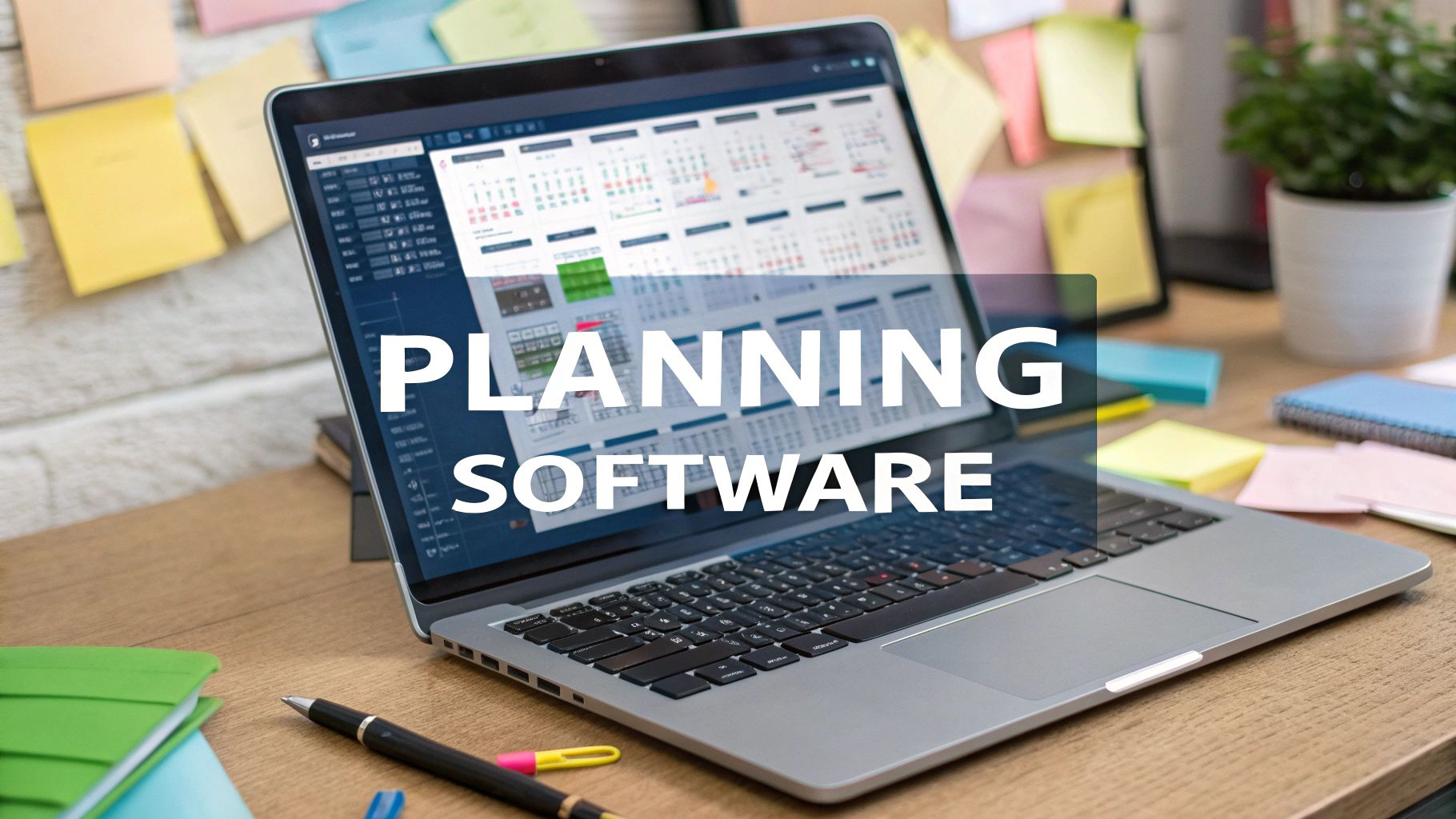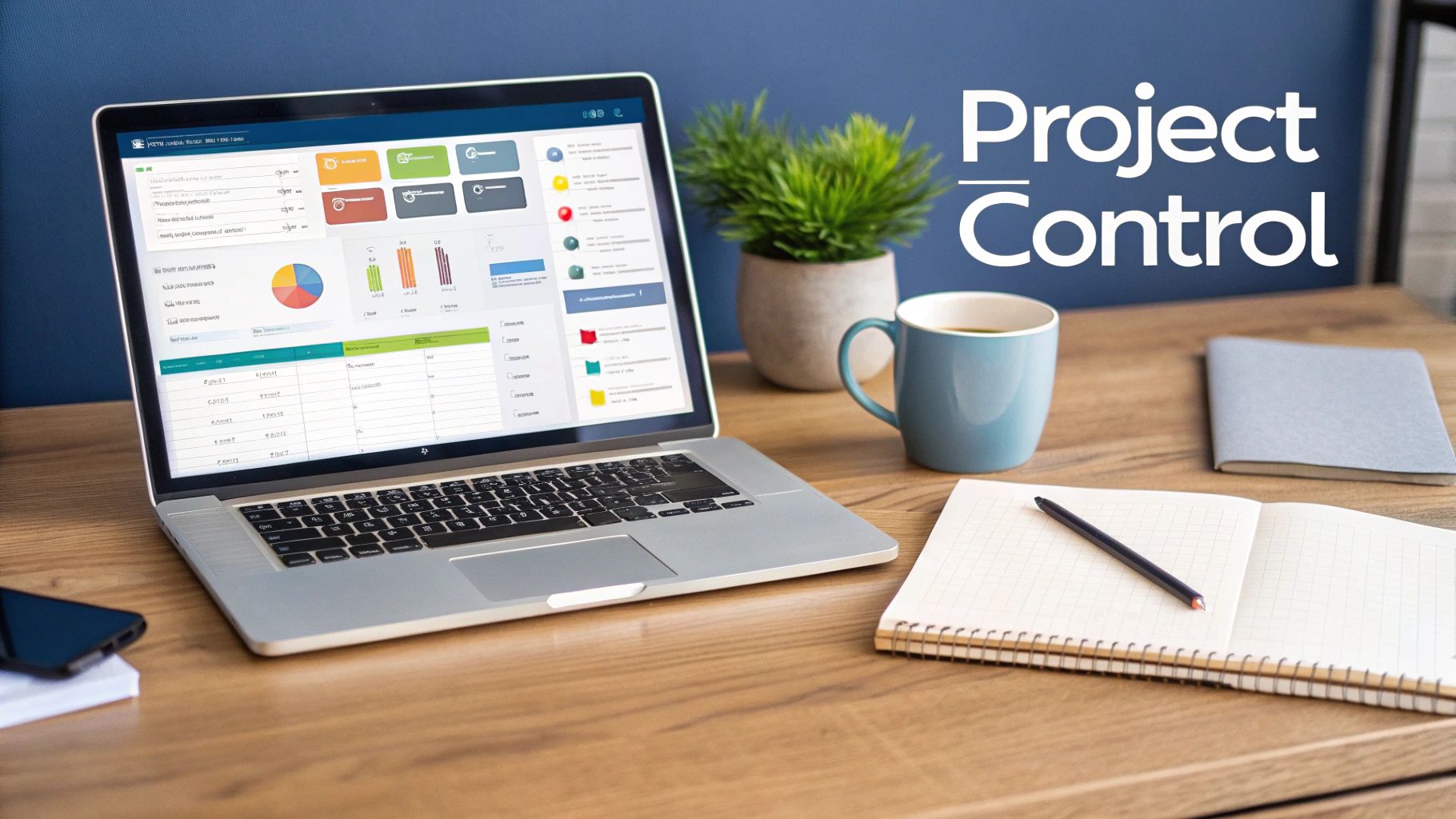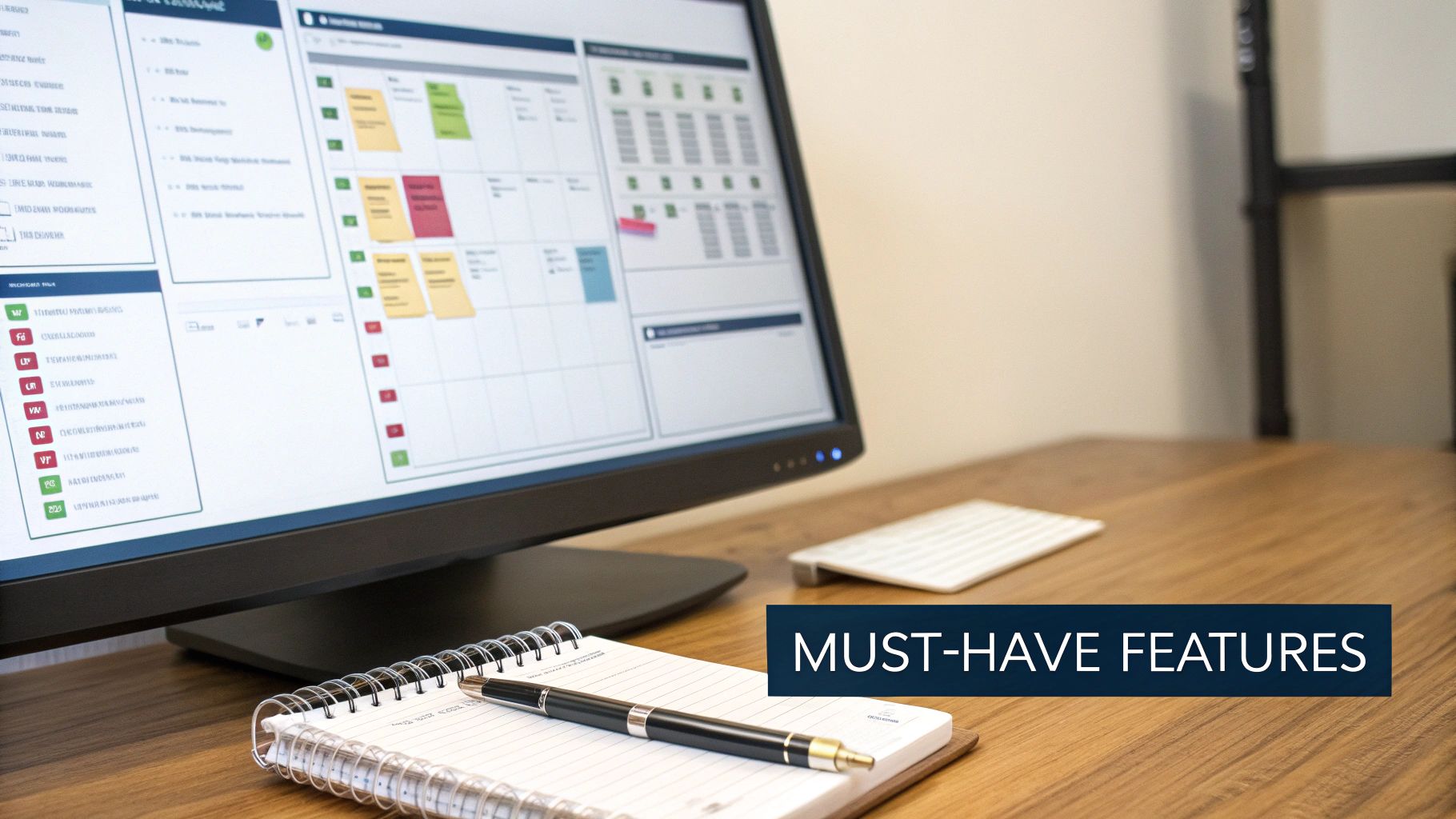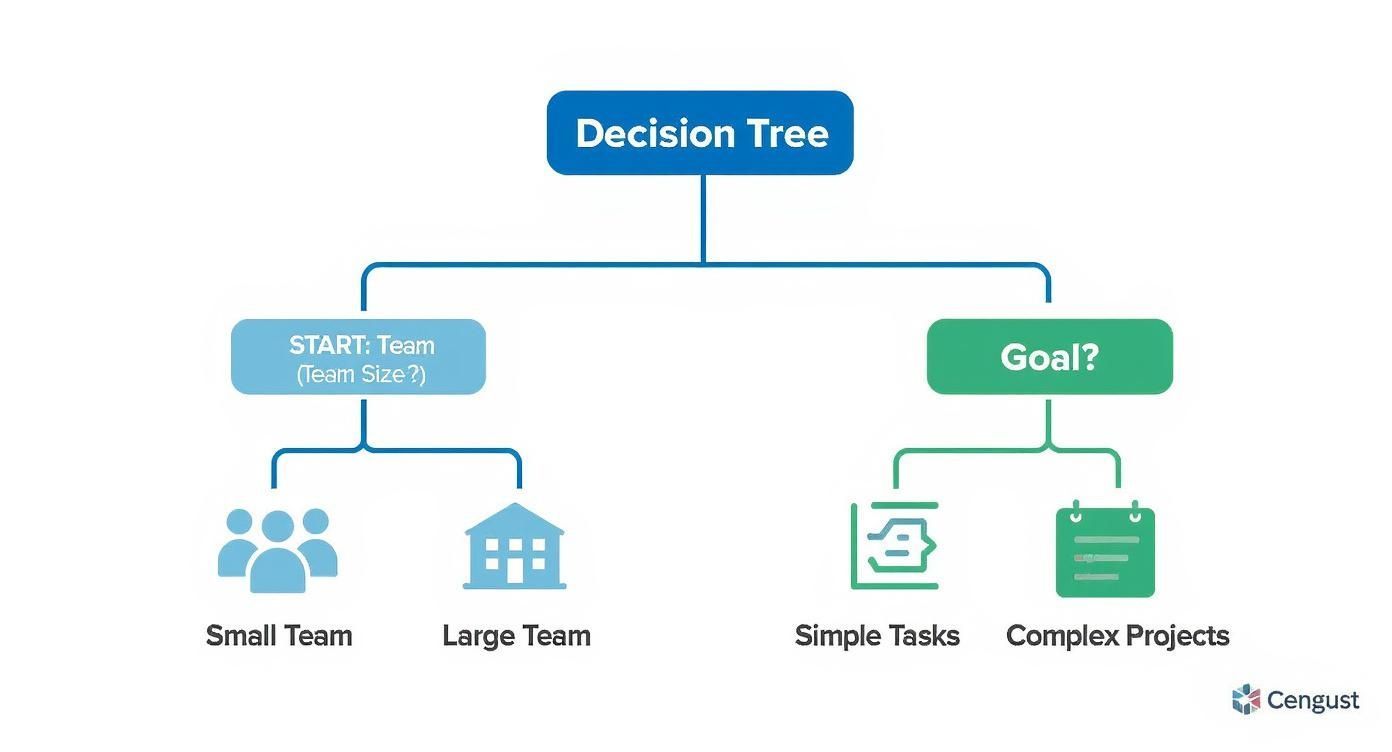
Are you constantly wrestling with missed deadlines and tangled communication? If that sounds familiar, the right software for planning can feel like swapping a chaotic workshop for a clean, organised command centre. It’s designed specifically to bring order, efficiency, and a shared sense of direction to any team project.
Conquering Project Chaos with Planning Software

That feeling of your projects constantly spiralling out of control is a common frustration. Important tasks slip through the cracks, communication becomes a messy web of emails and private messages, and deadlines feel more like suggestions than commitments. This disorganisation isn't just stressful; it directly hits your results and poisons team morale.
This guide is about tackling that chaos head-on. We're going to talk about software for planning not as just another complicated tool to learn, but as the central hub for getting things done. Think of it as finally ditching the scattered sticky notes and confusing spreadsheets for a single, dynamic dashboard where everyone is quite literally on the same page.
Moving From Disorganised to Directed
The whole idea behind these platforms is pretty simple: get everything in one place. At its heart, planning is just about thinking ahead to handle whatever the future throws at you. When you bring all the moving parts of a project together, you can make smarter, more informed decisions. These tools have come a long way from being simple digital checklists.
Planning is the act of thinking about the future. Sometimes that future holds risk and uncertainty. In those cases we plan more than when the future is highly predictable.
Modern planning software gives you a framework for turning big ideas into concrete, actionable steps. It helps you organise the work, assign resources where they're actually needed, and see progress as it happens. This guide will walk you through making that shift from scattered efforts to a smooth, predictable workflow.
So, what are the immediate wins you can expect?
- Total Visibility: Get a clear, top-down view of who is doing what and by when. It's the best way to spot potential bottlenecks before they bring everything to a halt.
- Smarter Collaboration: It creates a single source of truth for all communication, files, and updates. No more digging through email chains to find the latest version of a document.
- Clear Accountability: When tasks and deadlines are clearly defined and assigned, it’s easy for everyone to see their responsibilities and track progress.
By the time you're done with this article, you'll have a solid understanding of how to pick the right software for your team's needs, turning that project chaos into something you can actually manage and predict.
So, What Exactly is Planning Software?
Let's cut through the jargon. At its heart, planning software is a digital blueprint for your goals. A traditional blueprint shows you where to put walls and windows. Planning software shows you who’s doing what, when it’s due, and how every little piece fits into the bigger picture.
Its whole purpose is to pull every moving part of a project—tasks, deadlines, files, and conversations—into one single, organised space. It turns vague ideas into a solid, actionable plan that everyone on the team can see and follow. Without it, you’re left wading through a mess of spreadsheets, email chains, and sticky notes.
This central hub is often the difference between organised success and chaotic failure. Instead of guessing who has the latest version of a file or what the real status of a task is, the team has one source of truth. It’s a simple concept, but it saves countless hours of wasted time and cuts out the frustration of working with old information.
From Simple Lists to Powerful Platforms
The world of planning software isn’t a one-size-fits-all deal. It’s a huge spectrum of tools, each built for different levels of ambition and complexity. Knowing the main categories helps you pick the right kind of blueprint for what you’re trying to build.
Think of it like choosing a vehicle. You wouldn’t use a bicycle to move house, and you wouldn't fire up a massive lorry for a quick trip to the shops. The software you need depends entirely on the "journey" your project is on.
Here’s a quick breakdown of what you’ll find out there:
- Task Managers: These are the most basic planning tools, and they're perfect for individuals or small teams. They’re all about creating to-do lists, setting due dates, and ticking off individual tasks as they get done. Simple and effective.
- Project Management Platforms: This is a big step up, designed for collaborative teams juggling projects with multiple stages. They bring in features like visual timelines, ways to allocate resources, and built-in communication hubs. To really get a handle on this key category, it’s worth diving into the specifics of Project Management Software and what it can do.
- Enterprise Resource Planning (ERP) Systems: At the very top end, you have these massive systems built for entire organisations. They don’t just handle planning; they integrate it with other core business functions like finance, HR, and the supply chain.
The Real Job of Planning Software
No matter how simple or complex it is, every piece of planning software does one fundamental job: it makes work visible. And when work is visible, it becomes manageable. You can measure it, you can improve it. You can't fix a problem you can't see.
This visibility lets teams get instant answers to critical questions. Are we on schedule? Is anyone completely overloaded with work? Where are the bottlenecks slowing us down?
The essence of planning is to translate vision into action. Software acts as the bridge, providing the structure needed to cross from an abstract idea to a tangible result by making every step of the process clear and accountable.
Take a marketing team planning a new campaign. They might use a project management tool to map out the entire workflow, from the first brainstorming session and content creation right through to social media scheduling and analysing the results. Every single task is assigned to someone on the team with a clear deadline.
If the graphic designer starts falling behind, the project manager sees it immediately on the shared timeline. They can then shuffle deadlines or bring in some help to keep the whole campaign on track. This kind of proactive management is only possible when the plan is laid out in a shared, digital space. It’s the difference between actually steering the ship and just being a passenger hoping you'll end up somewhere good.
The Must-Have Features of Effective Planning Software

When you start shopping for software for planning, the feature lists can feel endless. Every tool promises the world, but which features actually move the needle? The key is to cut through the marketing noise and focus on the core functions that solve genuine planning headaches and help your team succeed.
Think of the features below as a practical checklist. These aren't just flashy extras; they are the bedrock of any system designed for clear, efficient, and collaborative work. Without them, even the most expensive software will likely fall short.
Intuitive Task Management
At its heart, planning is just breaking down a big idea into small, doable steps. That’s where task management comes in—it’s the engine that powers any planning tool, letting you assign work, set deadlines, and see how individual pieces are progressing.
This is more than just a simple to-do list. Good dedicated task management tools allow you to create subtasks, attach necessary files, flag priorities, and set up dependencies so one task can't begin until another is finished. It’s about creating a clear chain of action.
The real power of task management is making accountability clear. When every action item has an owner and a due date, the ambiguity that leads to missed deadlines simply disappears.
This function turns a vague goal like "launch new website" into a concrete series of steps: "Design mockups," "Write copy," "Develop backend," and "Test for bugs." That kind of clarity is non-negotiable for any team serious about getting things done.
Visual Project Timelines
A list of tasks is useful, but seeing how they all interconnect over time gives you the bigger picture. Visual timelines turn a static plan into a living roadmap, giving everyone an immediate sense of the project’s flow and current status.
Different teams think differently, so the best planning software offers a few ways to visualise the work.
- Gantt Charts: These are brilliant for complex projects where timing and dependencies are critical. They lay out tasks as bars on a calendar, showing start dates, end dates, and how everything overlaps.
- Kanban Boards: Perfect for agile teams and managing ongoing workflows. Tasks move across columns like "To Do," "In Progress," and "Done," making it incredibly easy to spot bottlenecks.
- Calendars: A shared team calendar is essential for scheduling meetings, hitting milestones, and managing deadlines. It keeps everyone on the same page without having to juggle multiple apps.
These visual aids aren't just for managers. They let every team member see how their work contributes to the overall goal, which builds a much stronger sense of ownership.
Resource Allocation and Management
One of the toughest parts of planning is making sure you have the right people available for the work without burning them out. Resource management features tackle this head-on by helping you track and assign your team’s most precious asset: their time.
These tools give you a clear view of who’s working on what and—just as importantly—how much capacity they have left. By visualising workloads, you can see who’s overstretched and shift tasks around before it becomes a real problem. For a deeper look at this, our guide on project management software for resource planning explains how this ensures projects are staffed for sustainable progress, not just a frantic push.
Integrated Communication Tools
Projects live and die by the quality of their communication. Toggling between your planning tool, email, and a separate chat app is a recipe for confusion and wasted time. This is exactly why built-in communication is a must-have.
Look for software that keeps conversations tied to the work itself. That means being able to comment directly on tasks, @mention teammates to pull them in, and share files right where the discussion is happening. This creates a single source of truth and stops people from digging through old email threads to find a decision. A central communication hub makes sure everyone has the latest information, dramatically cutting down on mistakes.
To give you a clearer picture, here's a breakdown of the features that truly matter and the benefits they bring to the table.
Essential Features in Modern Planning Software
| Feature | Primary Function | Key Benefit for Planning |
|---|---|---|
| Task Management | Creating, assigning, and tracking individual work items. | Turns abstract goals into actionable, accountable steps. |
| Gantt Charts | Visualising project timelines and task dependencies. | Provides a clear roadmap and highlights the critical path. |
| Kanban Boards | Managing workflow with visual cards and columns. | Instantly shows work progress and identifies bottlenecks. |
| Resource Management | Allocating team members' time and monitoring workloads. | Prevents burnout and ensures projects are realistically staffed. |
| Integrated Communication | Enabling comments, mentions, and file sharing on tasks. | Keeps all project discussions organised and in context. |
| Reporting & Analytics | Generating insights on project progress and team performance. | Allows for data-driven decisions to keep projects on track. |
Ultimately, choosing the right software comes down to finding a tool with a solid foundation. These core features provide the structure your team needs to plan effectively, stay aligned, and deliver great work without the chaos.
The Real-World Payoff of Planning Software
Bringing the right planning software into your workflow is about so much more than just tidying up your to-do lists. It’s a fundamental change in how your team gets things done. The real value isn’t buried in a long list of features; it’s in the tangible, day-to-day results that fuel growth and cut out the friction. These tools move you past the buzzwords and into a world of concrete improvements.
Think about the usual chaos of running a project through email. Updates get lost in long threads, key files are attached to messages you can’t find, and nobody has a clear, up-to-the-minute view of where things actually stand. It’s a reactive mess where small hiccups can quietly grow into major roadblocks because no one spots them in time.
Now, picture the clarity of a central planning dashboard. Every task, conversation, and file is in one spot, open for the whole team to see. This jump from scattered information to a single source of truth is the first—and most powerful—benefit you’ll feel.
Finally, Get Complete Project Visibility
One of the most immediate wins is achieving complete project visibility. This means you get a real-time, bird's-eye view of every moving part. It kills surprise roadblocks and puts an end to the constant "what's the status on this?" interruptions.
When work is visible, it becomes something you can actually measure and manage. You can see who’s working on what, spot potential delays before they wreck your timeline, and make smart decisions based on real progress, not just a gut feeling. That clarity lets teams get ahead of problems instead of constantly reacting to them.
The greatest benefit of planning software is its ability to create a shared consciousness for the team. When everyone sees the same plan, the same progress, and the same goals, alignment happens naturally, turning individual efforts into collective momentum.
This shift is a big deal for modern businesses. In the Netherlands, for example, the IT services market—which covers all sorts of planning and management software—is growing fast. It's expected to jump from USD 19.17 billion in 2025 to USD 35.10 billion by 2030, pushed by government efforts to encourage digital-first ways of working. It points to a bigger trend: companies are investing in these tools to get a serious competitive edge. You can find more details on how the Dutch IT market is changing over at Mordor Intelligence.
Build Seamless Team Collaboration
Good collaboration is the engine of any successful project, and planning software gives it the structure it needs to run smoothly. By putting all communication in one place, these tools create a focused space where conversations happen right alongside the work they’re about.
Instead of digging through different chat apps or email chains, team members can comment directly on tasks, mention colleagues to ask a quick question, and attach files exactly where they’re needed. This builds an organised, searchable history of all project-related decisions and discussions.
Here are some practical actions this enables:
- Less Miscommunication: When every conversation is tied to a specific task, the risk of misunderstandings or someone working from old info plummets.
- Faster Decisions: Key people can be tagged for approvals, making sure decisions get made quickly without holding everyone else up.
- More Accountability: With clear task ownership and open communication, it’s easy for everyone to see their responsibilities and how their work fits into the bigger picture.
In the end, these platforms build a culture of clarity and shared purpose. They knock down the walls between departments and make sure every team member has the context they need to do their best work, which leads to smarter processes and better results, every time.
How to Choose the Right Software for Your Team
Picking the right software for planning can feel like a huge decision, but it doesn’t have to be a shot in the dark. If you break the process down into a few practical steps, you can go from being swamped with options to confidently choosing a tool your team will actually want to use. The real goal is finding a solution that fits your specific challenges perfectly.
It all starts with an honest look at how your team works right now. Before you even think about features, you need to put your finger on the exact problems you’re trying to fix. Are deadlines slipping through the cracks because no one has a clear overview? Is communication a mess, scattered across five different apps? Pinpointing these core issues first means you’ll be shopping for solutions, not just shiny features.
Define Your Team’s Core Needs
Every team’s rhythm is different. A tool that’s a game-changer for one company could be a total dud for another. Start by answering these questions to sketch out your needs:
- What are our biggest planning pain points? (e.g., missed deadlines, poor communication, unclear priorities).
- How complex are our typical projects? (e.g., simple to-do lists vs. multi-stage projects with dependencies).
- How large is our team, and will it grow? (This determines the need for scalability).
- What is our budget per user, per month? (Having a number in mind helps narrow options).
Thinking about how complex your projects are will point you toward either a simple task manager or a more heavy-duty project management platform. A great way to begin is by considering your team size and what you’re trying to achieve, like in the decision tree below.
This visual helps map out those first few decision points, guiding you based on how big your team is and the scope of your projects.
 As you can see, a small team knocking out simple tasks has completely different needs than a large organisation juggling complex initiatives.
As you can see, a small team knocking out simple tasks has completely different needs than a large organisation juggling complex initiatives.
Scalability is another big one. The tool you pick today should still work for you as your team gets bigger. Ask yourself if the software can handle more users, more projects, and trickier workflows down the line without forcing you to start all over again. Choosing a scalable tool now will save you a world of pain later.
Evaluate Integrations and Usability
Even the most powerful software is useless if it doesn’t play nicely with your team's other tools. A critical step is to check for integrations with the apps you already live in every day, like Slack, Google Drive, or your email client. When your planning tool connects seamlessly with your other apps, it cuts down on wasted time and keeps things running smoothly.
This push for connected, cloud-based tools is part of a much bigger trend. The Netherlands' software as a service (SaaS) market has grown massively, with companies jumping on board to become more efficient. From finance to manufacturing, businesses are adopting these tools, often with a nudge from government initiatives that favour cloud systems. You can read more about this growing market and its effect on business operations at 6wresearch.com.
The best software is the one your team actually uses. Prioritise a clean, intuitive interface and a minimal learning curve over a long list of advanced features that might go untouched.
Usability is everything. Before you sign any contracts, make full use of free trials. This is your chance to let your team put the software through its paces with real work. Get feedback from the people who will be in it all day. Do they find it easy to navigate? Does it make their job easier, or does it just add more clicks? This hands-on testing is the single best way to make sure people will actually adopt it. For more on managing team adoption and performance, take a look at our guide on workforce management software.
Understand Pricing and Make Your Decision
Finally, you have to get to grips with the pricing models to make sure there are no nasty surprises. Most planning tools are sold on a per-user, per-month basis, but it pays to look a little closer.
- Tiered Plans: Find out exactly which features are included in each price tier. Sometimes, the one function you really need is locked away in a more expensive plan.
- Hidden Fees: Don't be afraid to ask about extra costs for things like data storage, certain integrations, or premium support.
- Annual vs. Monthly: Check if you can get a discount for paying annually. It can lead to big savings if you’re confident you’ve found the right fit.
By following this structured approach—defining your needs, checking usability and integrations, and getting clear on the costs—you can choose a software for planning that doesn’t just fix today's headaches but also grows with your team. It’s a methodical process that ensures you’re investing in a tool that truly empowers your people and delivers real results.
See How Top Industries Use Planning Software

Talking about features is one thing, but the real magic of planning software happens when you see it in the wild. These tools aren’t generic solutions; they morph to solve unique, industry-specific headaches. From the organised chaos of a construction site to the fluid deadlines of a creative agency, the right software brings much-needed structure.
Let's look at a few mini-case studies. Each one shows how a specific industry hit a wall and used a planning tool to break through it, highlighting just how versatile these platforms can be.
Creative Agencies Visualising Campaign Flow
Managing a client campaign is a masterclass in juggling. A creative agency has to track everything from the first concept sketch to the final launch, with endless deadlines for copy, design, client feedback, and publication. Without a clear visual map, tasks slip through the cracks and approvals create bottlenecks.
This is exactly where visual planning boards come into their own.
- The Problem: The team was drowning, trying to track dozens of creative assets at once. Communication was a messy mix of emails and chat messages, leading to constant confusion about which version of a design or copy was the final one.
- The Solution: They brought in software with Kanban boards. Each client campaign got its own board, and every task—from "Drafting blog post" to "Client approval"—became a card. As work got done, cards moved across the columns: "To-Do," "In Progress," and finally, "Complete."
This simple visual shift brought instant clarity. The project manager could see the status of the entire campaign at a glance, keeping everything flowing smoothly.
Construction Firms Managing On-Site Milestones
In construction, one small delay can trigger a massive domino effect, pushing the entire project timeline back and sending costs soaring. Trying to coordinate critical milestones, equipment, and subcontractors is a monumental task.
For projects where timing is everything, Gantt charts are the definitive tool. They transform a complex web of dependencies into a clear, linear roadmap, ensuring that every piece of the puzzle fits together exactly when it should.
A construction firm relies on software for planning to keep its multi-million-dollar projects from going off the rails. Schedulers use Gantt charts to map out every phase, from laying the foundation to the final inspections, clearly showing how one task depends on another. This guarantees materials and crews are on-site precisely when they’re needed, eliminating expensive downtime. Plus, by accurately tracking time spent on projects this way, they gather invaluable data for future bids and resource planning.
Tech Startups and Financial Institutions
For tech startups, agile development is the name of the game, making planning software with sprint features an absolute necessity. These tools help teams break down huge development goals into manageable two-week sprints, track progress in daily stand-ups, and pivot quickly when things change.
Meanwhile, financial institutions use powerful Enterprise Resource Planning (ERP) systems to navigate complex projects bogged down by regulatory compliance and risk assessment. The demand from this sector is a major force in the market. In the Netherlands alone, the ERP market was valued at USD 2.51 billion in 2024 and is expected to climb to USD 4.82 billion by 2030. This shows just how vital these systems are for managing huge, high-stakes operations. You can learn more about the Dutch ERP software market growth on NextMSC.com.
A Few Common Questions About Planning Software
To wrap things up, let's clear the air on a few questions that often come up when people are choosing planning software. Think of this as the last piece of the puzzle to help you move forward with confidence.
Task Management Versus Project Management
One of the most common points of confusion is the difference between task and project management. The easiest way to think about it is this: task management is about the individual trees, while project management is about the entire forest.
- Task Management Tools are built for the day-to-day. They focus on individual to-do lists, due dates, and the status of specific jobs. They're perfect for individuals or small teams with straightforward work.
- Project Management Software is designed to orchestrate the big picture. It’s for complex initiatives with lots of moving parts, dependencies, and stakeholders, giving you a high-level view of timelines, resources, and overall progress.
How Much Should We Budget for This?
So, what’s this going to cost? The honest answer is: it depends. The price can swing from completely free to thousands of pounds a month for a large company. It almost always comes down to the number of people on your team and how many advanced features you actually need.
Most good providers use a tiered pricing model. A small team could get started on a plan for around £10-£20 per person, per month. As you grow, you might need more powerful features like in-depth analytics or special integrations, which could push the cost to £30 or more per user. It's always a smart move to think about where your team will be in a year to avoid getting boxed into a surprise upgrade.
Can We Get By With a Free Tool?
Free planning tools can be a fantastic starting point, no doubt. For small teams or really simple projects, a basic Kanban board or task list might be all you need.
But they almost always come with a catch. Usually, you'll hit a limit on the number of users, projects, or file storage. For a professional team that's trying to grow, those limits can become a real bottleneck, fast. Paid plans typically unlock the things that matter as you scale: advanced reporting, priority support, and better security.
Ready to see how your team really works? WhatPulse gives you the privacy-first analytics needed to understand software usage, track time on projects, and make decisions based on data, not guesswork. See how your plans turn into real-world activity and find out what your team is truly capable of. Explore WhatPulse Professional today!
Start a free trial